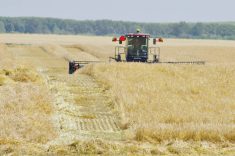Reuters / Egypt wants to double the capacity of its wheat silos in the next three or four years and is considering changing a bread-subsidy mechanism to prevent smuggling or illegal trade in subsidized grain.
Egypt’s new government has been looking at ways to better target subsidies and reduce waste as it seeks to plug a ballooning budget deficit.
However, while the government is seeking to cut back on at least some energy subsidies, there is no talk of cutting supplies of subsidized bread, a politically sensitive issue, even if the mechanism for keeping loaves cheap could be changed.
Read Also

Manitoba sclerotinia picture mixed for 2025
Variations in weather and crop development in this year’s Manitoba canola fields make blanket sclerotinia outlooks hard to pin down
Egypt now has 25 wheat silos each with capacity for 30,000 tonnes and aims to double that number, said Nomani Nomani, vice-chairman of the General Authority for Supply Commodities.
“We are… concerned with storage especially as local wheat supplies increased this year,” he said.
Egypt, the world’s biggest wheat importer, bought 3.7 million tonnes of wheat from local farmers this year, Nomani said.
He also said the authorities were considering changing how the subsidy was applied to halt smuggling of wheat from Egypt to neighbours like Sudan and Libya, or leakage of subsidized wheat on to the local market where illegal traders pocketed the difference in price.
Many Egyptians depend on the subsidized saucer-sized flat loaves selling for just five piastres (less than one cent).
Nomani said that instead of selling subsidized wheat, the subsidy would be applied at the final stage of the process when it was sold as loaves, which would curb smuggling.


















